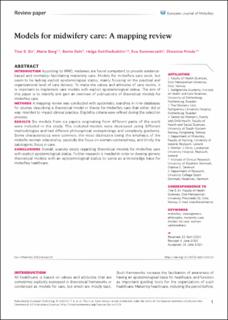| dc.contributor.author | Eri, Tine Schauer | |
| dc.contributor.author | Berg, Marie | |
| dc.contributor.author | Dahl, Bente | |
| dc.contributor.author | Gottfreðsdóttir, Helga | |
| dc.contributor.author | Sommerseth, Eva | |
| dc.contributor.author | Prinds, Christina | |
| dc.date.accessioned | 2021-06-01T11:58:57Z | |
| dc.date.available | 2021-06-01T11:58:57Z | |
| dc.date.created | 2020-10-23T11:13:48Z | |
| dc.date.issued | 2020-07-30 | |
| dc.identifier.citation | European Journal of Midwifery. 2020, 4 (30), (1-17). | en_US |
| dc.identifier.issn | 2585-2906 | |
| dc.identifier.uri | https://hdl.handle.net/11250/2757230 | |
| dc.description.abstract | INTRODUCTION According to WHO, midwives are found competent to provide evidence-based and normalcy-facilitating maternity care. Models for midwifery care exist, but seem to be lacking explicit epistemological status, mainly focusing on the practical and organizational level of care delivery. To make the values and attitudes of care visible, it is important to implement care models with explicit epistemological status. The aim of this paper is to identify and gain an overview of publications of theoretical models for midwifery care.METHODS A mapping review was conducted with systematic searches in nine databases for studies describing a theoretical model or theory for midwifery care that either did or was intended to impact clinical practice. Eligibility criteria were refined during the selection process. RESULTS Six models from six papers originating from different parts of the world were included in the study. The included models were developed using different methodologies and had different philosophical underpinnings and complexity gradients. Some characteristics were common, the most distinctive being the emphasis of the midwife–woman relationship, secondly the focus on woman-centeredness, and thirdly the salutogenic focus in care. CONCLUSIONS Overall, scarcity exists regarding theoretical models for midwifery care with explicit epistemological status. Further research is needed in order to develop generic theoretical models with an epistemological status to serve as a knowledge base for midwifery healthcare | en_US |
| dc.language.iso | eng | en_US |
| dc.publisher | European Publishing | en_US |
| dc.relation.ispartofseries | European Journal of Midwifery;4:30 | |
| dc.rights | Navngivelse-Ikkekommersiell 4.0 Internasjonal | * |
| dc.rights.uri | http://creativecommons.org/licenses/by-nc/4.0/deed.no | * |
| dc.subject | Midwifery | en_US |
| dc.subject | Salutogenesis | en_US |
| dc.subject | Philosophy | en_US |
| dc.subject | Maternity care | en_US |
| dc.subject | Models for care | en_US |
| dc.subject | Woman-centeredness | en_US |
| dc.title | Models for midwifery care: A mapping review | en_US |
| dc.type | Peer reviewed | en_US |
| dc.type | Journal article | en_US |
| dc.description.version | publishedVersion | en_US |
| dc.rights.holder | © 2020 Eri T. S. et al. | en_US |
| dc.source.articlenumber | 30 | en_US |
| cristin.ispublished | true | |
| cristin.fulltext | original | |
| cristin.qualitycode | 1 | |
| dc.identifier.doi | https://doi.org/10.18332/ejm/124110 | |
| dc.identifier.cristin | 1841771 | |
| dc.source.journal | European Journal of Midwifery | en_US |
| dc.source.volume | 4 | en_US |
| dc.source.pagenumber | 1-17 | en_US |

